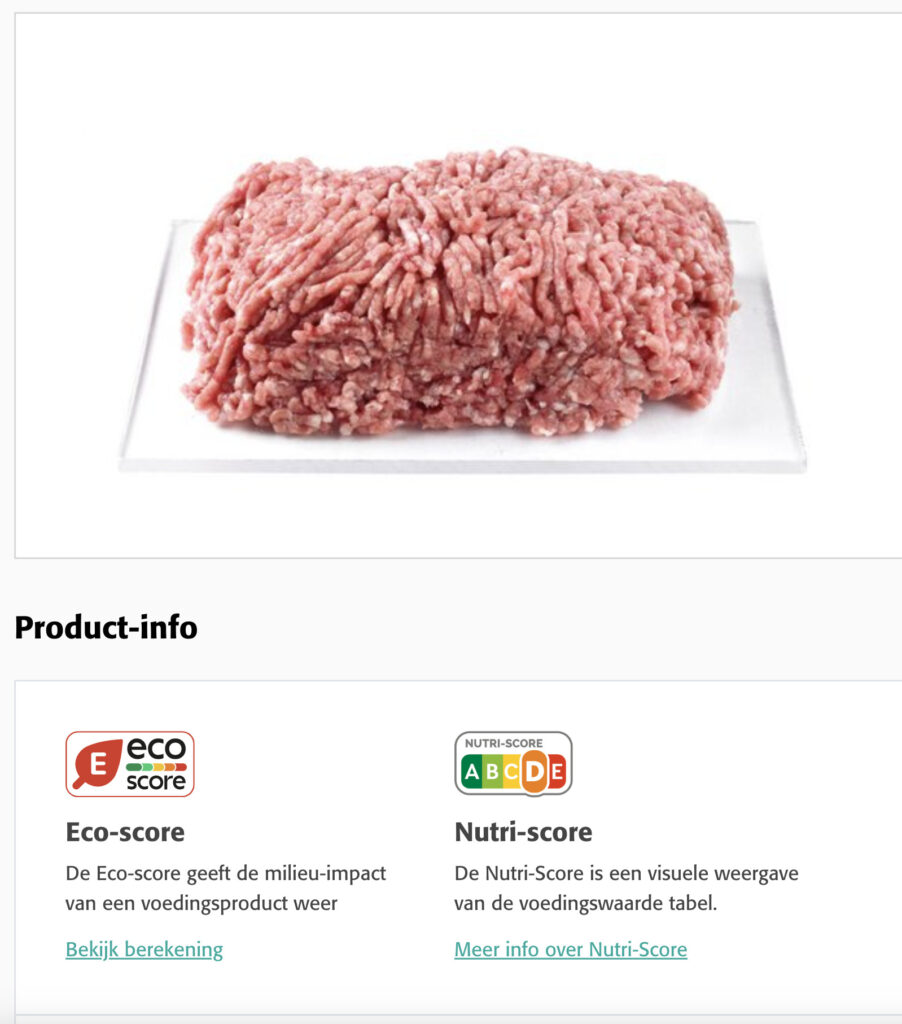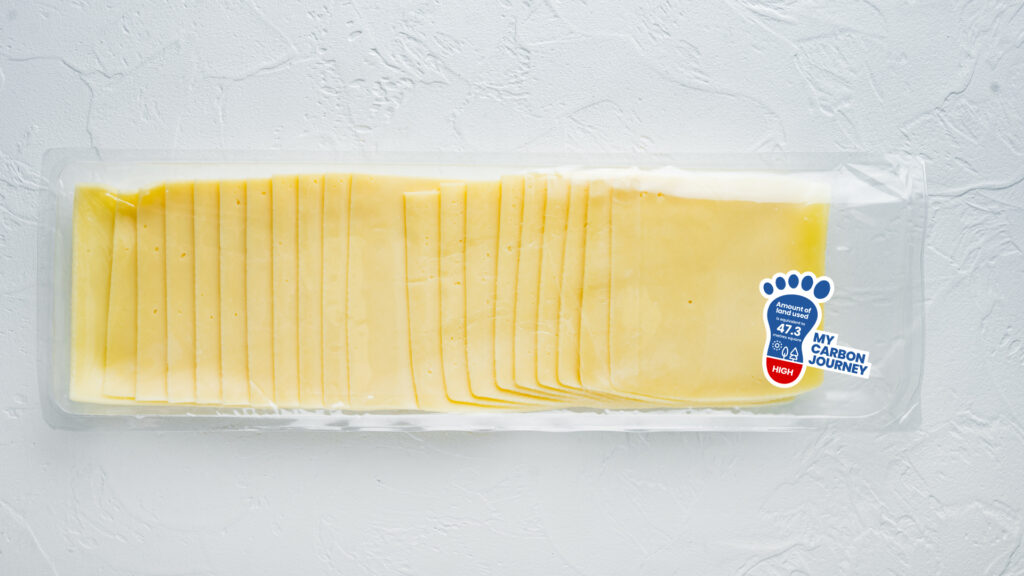Nutri-Score and Eco-Labels: Is Carbon & Nutrition Labelling the Future of Food Packaging?
Nutri-Score 與環保標籤:碳足跡與營養標示是食品包裝的未來嗎?
7 Mins Read 7 分鐘閱讀
Consumers are more focused on personal and planetary health than ever before, governments are clamping down on greenwashing, and businesses are offering services to cut climate impacts and provide better labelling – are labels like Nutri-Score and Eco-score the future of food packaging?
消費者比以往任何時候都更關注個人與地球的健康,政府正加強打擊綠色洗牌,企業則提供減少氣候影響和改善標示的服務——像 Nutri-Score 和 Eco-score 這樣的標籤會是食品包裝的未來嗎?
Two weeks ago, Oatly launched a new campaign challenging the dairy industry to showcase its climate footprint. While the company itself has been doing this for a few years now, this felt a little different. It’s one of the world’s largest oat milk companies directly calling out the industry it hopes to replace – and it comes at a time of reckoning for the livestock industry.
兩週前,Oatly 發起了一場新活動,挑戰乳製品產業公開其氣候足跡。雖然該公司本身已經推行這項做法好幾年了,但這次感覺有些不同。這是全球最大的燕麥奶公司之一,直接點名它希望取代的產業——而這正值畜牧業面臨清算的時刻。
Recent investigations have shown how departments of the UN and the EU have been heavily influenced by lobbyists from the animal industry on matters including environmental sustainability and caged farming, respectively. The former is striking, given that officials were pressured to water down their reporting about the effects of the livestock sector’s emissions.
近期調查顯示,聯合國和歐盟的相關部門在環境永續性和籠養畜牧等議題上,分別受到動物產業遊說團體的強烈影響。前者尤為引人注目,因為官員們曾受到壓力,淡化有關畜牧業排放影響的報告內容。
And earlier this week, it emerged that food production in Brazil, the world’s largest beef exporter, accounts for 74% of its total emissions. And of these, 78% are associated with the beef industry. It comes on the back of alt-protein companies – which have long focused on the environmental superiority of their analogues – doubling down on the health aspects of their products.
本週早些時候,有消息指出,巴西作為全球最大的牛肉出口國,其食品生產佔該國總排放量的 74%。而其中有 78%與牛肉產業相關。這是在替代蛋白公司——長期以來專注於其產品環保優勢——加強推廣其產品健康層面的背景下發生的。
What we eat is just as crucial as how it affects us and the planet – and increasingly so. It’s more important than ever for brands to be transparent on-pack about the health and climate credentials of their offerings, as evidenced by recent scientific studies and consumer surveys on product labelling and government clampdowns on greenwashing.
我們所吃的食物與其對我們自身及地球的影響同樣重要,且這一點日益顯著。品牌在包裝上透明呈現其產品的健康與氣候相關資訊,比以往任何時候都更加重要,這一點可從近期關於產品標示的科學研究、消費者調查以及政府對綠色洗牌的嚴格打擊中得到證明。
Will product labels like Nutri-Score and Eco-score be standard images on food packaging globally?
像 Nutri-Score 和 Eco-score 這樣的產品標籤會成為全球食品包裝上的標準圖示嗎?

Health and sustainability are key for consumers
健康與永續是消費者的關鍵考量
Let’s take meat as an example. It has a much higher carbon footprint than plant-based or cultivated alternatives, and most red and processed meat products that have a climate label on their packaging will have a low score. In Belgium, for example, a mince and pork blend at Colruyt supermarket has a red E Eco-score, the lowest possible. Similarly, in Scotland, Lidl trialled carbon labelling in 105 supermarkets in 2021, and one brand’s bacon had a C rating.
以肉類為例。肉類的碳足跡遠高於植物性或培育替代品,而大多數包裝上有氣候標籤的紅肉和加工肉品,其分數通常偏低。例如,在比利時,Colruyt 超市販售的一款絞肉與豬肉混合產品,其 Eco-score 為紅色 E,為最低分數。同樣地,蘇格蘭的 Lidl 在 2021 年於 105 家超市試行碳標籤,其中一品牌的培根獲得 C 級評價。
These labels have been found to influence people’s purchasing decisions, as evidenced by a peer-reviewed study of 255 Brits (a small sample size) last month. It found that 63% of consumers would be deterred from purchasing meat if it had an eco score in the red, while 52% would consider buying a meat alternative if it had a better rating. Meanwhile, 58% said they’re interested in eco-labels, but require more information – highlighting the need for more education and awareness among consumers.
這些標籤被發現會影響人們的購買決策,根據上個月一項針對 255 名英國人的同行評審研究(樣本量較小)顯示,63%的消費者如果肉品的環保評分為紅色,會因此不願購買,而 52%的人則會考慮購買評分較好的肉類替代品。與此同時,58%的人表示對環保標籤感興趣,但需要更多資訊——這突顯出消費者教育和意識提升的必要性。
In 2020, Carbon Trust carried out an analysis of three global YouGov polls totalling 10,540 participants, finding that two-thirds of respondents find carbon labelling a good idea across all countries surveyed. Support was highest in Italy (82%), France (80%) and Spain (79%). It’s because of these attitudes that industry giants like Upfield and Hilton have introduced carbon labels on their products and menus, respectively, while Unilever has committed to doing so (although it hasn’t implemented anything yet).
2020 年,Carbon Trust 對三項全球 YouGov 調查進行分析,總計 10,540 名參與者,發現三分之二的受訪者認為碳標籤是一個好主意,且在所有受訪國家中均有此共識。支持度最高的國家分別是義大利(82%)、法國(80%)和西班牙(79%)。正因為這些態度,產業巨頭如 Upfield 和 Hilton 分別在其產品和菜單上引入了碳標籤,而 Unilever 也承諾將採用碳標籤(儘管尚未實施)。
In terms of health labels, a French study of 1,201 adolescents aged 11-17 last year revealed that 54% had already been impacted by Nutri-Score labels during food purchases, indicating how these labels affect behaviours across demographics. This is key since peer-reviewed research last month revealed that for children and adolescents, increased plant-based food consumption alongside food fortification and supplementation where needed is recommended for sustainable and nutritionally adequate diets.
在健康標籤方面,法國去年對 1,201 名 11 至 17 歲青少年的研究顯示,已有 54%的人在購買食品時受到 Nutri-Score 標籤的影響,這反映出這些標籤如何影響不同族群的行為。這一點非常重要,因為上個月的同行評審研究指出,對於兒童和青少年来說,增加植物性食品的攝取,並在需要時進行食品強化和補充,是實現可持續且營養充足飲食的建議做法。
In general, health and sustainability are growing drivers of consumers’ food choices. Last year, an 8,000-person McKinsey survey covering the US, UK, France and Germany revealed that between 37-52% of people have cut their meat consumption in the last year out of health concerns, with similar or higher numbers for salt, fat, sugar and processed foods. Across the four countries, eating more fresh fruits and vegetables was the most significant change they’ve made in their diets since the pandemic.
整體而言,健康與永續性正日益成為消費者選擇食品的主要動力。去年,麥肯錫針對美國、英國、法國和德國進行了一項涵蓋 8,000 人的調查,結果顯示有 37%至 52%的人在過去一年因健康考量減少了肉類攝取,而對鹽、脂肪、糖和加工食品的減少比例則相當或更高。在這四個國家中,自疫情以來,增加新鮮水果和蔬菜的攝取是他們飲食中最顯著的改變。
Additionally, 60% said they value sustainable solutions – but health came out as a bigger priority, with 60% choosing it as their most important eating priority, versus a third who picked sustainability. Another survey from 2022 showed that 73% of Brits felt it was important for food and drink to have low carbon footprints, while 49% wanted to see carbon footprint labelling on products.
此外,有 60%的人表示他們重視永續解決方案,但健康被視為更重要的優先事項,有 60%的人選擇健康為他們最重要的飲食優先考量,而只有三分之一的人選擇永續。另一項 2022 年的調查顯示,73%的英國人認為食物和飲料擁有低碳足跡很重要,49%的人希望產品上能標示碳足跡。
Consumers want food that’s better for them and the planet, and companies that can help them buy the right products will likely be winners. That’s what a study found earlier this month, stating that “food companies can enhance their sustainability efforts by prompting customers to think before nudging them into consuming more sustainable food”.
消費者希望食物對自己和地球更有益,而能幫助他們選擇正確產品的公司很可能會成為贏家。本月初的一項研究指出,「食品公司可以透過促使顧客思考,而非僅僅推動他們消費更多永續食物,來提升其永續發展的努力」。

Increased government attention
政府關注度提升
There are more regulations and proposals regarding carbon and nutrition labelling, as well as greenwashing. In 2022, the EU Commission announced it would introduce “harmonised mandatory front-of-pack nutrition labelling” to “empower consumers to make informed, healthy and sustainable food choices” by the end of the year, although this has now been postponed and the legislation is yet to be implemented.
關於碳標籤與營養標示,以及綠色漂綠的相關法規與提案日益增多。歐盟委員會於 2022 年宣布,將在年底前推出「統一強制性包裝正面營養標示」,以「賦予消費者做出明智、健康且永續的飲食選擇的能力」,但此計畫現已延後,相關法規尚未實施。
But some countries – like France, Spain and Belgium – have already adopted Nutri-Score labels, while certain brands in Portugal, Slovenia, Austria and Ukraine have voluntarily begun using these labels to better inform consumers. Food products in the UK also have a nutrition label designed by the Food Standards Agency.
但有些國家——如法國、西班牙和比利時——已經採用了 Nutri-Score 標籤,而葡萄牙、斯洛維尼亞、奧地利和烏克蘭的某些品牌也自願開始使用這些標籤,以更好地告知消費者。英國的食品產品也有由食品標準局設計的營養標籤。
Meanwhile, France and Denmark are set to introduce environmental labelling schemes in 2024. There have been calls for a similar plan in the UK too. These moves signal a wider effort to curb greenwashing across product categories. The UK’s new Green Claims Code lays out a six-point checklist to help businesses make credible environmental claims.
同時,法國和丹麥預計在 2024 年推出環境標籤計劃。英國也有呼籲推動類似方案的聲音。這些舉措顯示出在各產品類別中遏制綠色漂綠的更廣泛努力。英國新的《綠色聲明守則》列出六點檢查清單,幫助企業提出可信的環境聲明。
The EU, meanwhile, finalised a new law to effectively ban greenwashing last month, banning terms like ‘carbon-neutral’ and ‘eco-friendly’ from product labels, unless businesses can provide “proof of recognised excellent environmental performance relevant to the claim”. One of its proposed sister laws, the Green Claims Directive, mandates businesses to assess and meet new minimum “substantiation requirements” for sustainability claims – but progress on this has halted.
歐盟則於上個月完成了一項新法案,有效禁止綠色漂綠,禁止在產品標籤上使用「碳中和」和「環保」等詞彙,除非企業能提供「與聲明相關的公認卓越環境表現證明」。其提議中的姊妹法案《綠色聲明指令》要求企業評估並符合新的最低「可證明要求」以支持永續性聲明,但此項進展已暫停。
“Generic environmental claims are popping up everywhere, from food to textiles. Consumers end up lost in a jungle of green claims with no clue about which ones are trustworthy,” said Ursula Pachl, deputy director of consumer advocacy group BEUC.
She added: “Consumers have a crucial role to play in the green transition, so it’s good news they will have more information to make sustainable choices when buying food, new clothes or home appliances. The new EU rules will enable consumers to navigate through a sea of green claims and choose durable products that live up to expectations.”
她補充說:「消費者在綠色轉型中扮演著關鍵角色,因此他們將擁有更多資訊來做出可持續的選擇,無論是在購買食品、新衣服或家用電器時,這都是好消息。新的歐盟規定將幫助消費者在眾多綠色宣稱中辨識,並選擇符合期待的耐用產品。」

Startups and data solutions creating better labels
A bunch of businesses and organisations are helping businesses measure their eco impacts and put climate and nutrition labels on their products. UK food regulatory consultants Ashbury recently conducted research to gauge what these labels could look like, and used AI-generated images to illustrate the results. Products like beef, milk, cheese and dark chocolate all had high footprints, while items like tea had low scores.
In 2021, British startup Provenance launched its Provenance Framework, an open-source rulebook listing the criteria companies need to fulfil to make a true environmental claim, and avoid greenwashing and misleading consumers. And Agribalyse, a French life-cycle assessment database for food and agriculture, provides environmental reference data on over 2,500 products consumed in France (including imported foods).
There’s also the True Animal Protein Price coalition, which is lobbying governments to reflect the true climate cost of these products and increase the VAT on meat to offset the tax on fresh produce. Meanwhile, startups like My Emissions, Planet FWD, Foodsteps, Reewild and Klimato all help food businesses reduce their emissions and better label their products.
Speaking on the Investing in Regenerative Agriculture and Food podcast, Tina Owens, a regenerative agriculture consultant, highlighted how only 1% of nutrition data is tracked on food labels, explaining that this is a huge opportunity for brands. ”If we know 1% of nutrition, we’re not even at the rotary phone stage of nutrition. We’re at the telegraph stage,” she explained. “And yet, we as consumers know to seek those things out for purchasing. And so, the bare minimum… is what we’re after – we’re after this foundational step.”



